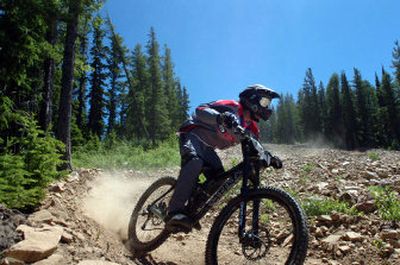Bike festival rocks Silver Mountain

KELLOGG – High above this former mining town, a mountain biker shot across the lip of a jump, paused for a moment mid-air against a backdrop of ski runs and forested hills, and then dropped out of sight.
“That guy really rails,” Stephen Lane, Silver Mountain’s marketing director, said. “He’s tough to keep up with.”
Mountain bikes have always been welcome at Silver Mountain. But about three years ago, the Kellogg resort began developing a 30-mile trail system with jumps and switchbacks and erosion controls to prevent the trails from washing out.
On Saturday, the mountain kicked off Silveroxx, a weekend of races, trick jumping and live music that attracted riders from around the Northwest. Today’s race has a $3,000 prize purse for the top riders.
Cindy Bartles, a 33-year-old coffee shop owner from Olympia, drove six hours to Kellogg with her longtime boyfriend and another friend.
“The mountains around us aren’t into this,” Bartles said. “And the people at Silver have been really friendly.”
Silver Mountain is hoping to mimic Whistler Mountain’s success in attracting mountain bikers. At the Canadian resort, there are waits for the lifts in both the summer and winter.
“They’ve got the Holy Grail of trails,” Lane said.
On a busy summer day, 200 people might ride the gondola to the top of Silver Mountain, at a cost of $15 per person. About half of them will be mountain bikers, Lane said. It’s still a fraction of the resort’s winter business, which attracts about 2,000 skiers on a busy day.
But every bit counts, according to Lane.
“It’s hard to just operate in the winter,” he said. “You need to operate 365 days per year.”
The sport requires superb conditioning, reservoirs of nerve, and pockets of expendable cash. Some cyclists pay $5,000 to $7,000 for specialty bikes to handle high-speed jumping. They also suit up in protective gear that girds their spine, shoulders, arms and internal organs.
“You’ve got to keep those organs nice and tight,” said Justin Lowery, a 21-year-old club racer for the University of Idaho. “You can fall all kinds of ways.”
Roger Baker, a 63-year-old retired logger and construction worker from Kingston, Idaho, began extreme mountain biking two years ago, after he entered a mini-triathlon.
Baker invested in $600 in body armor but nevertheless accepts the risk of cruising down trails at 25 mph or faster.
“It keeps you alert,” Baker said. “In the course of a ride down the mountain, you will make and physically react to a thousand decisions. It’s very exciting.”
There is a downside to the adrenaline rush: injury.
As Lane gave a quick tour of the route, a teenage rider bounced across a jump, his front wheel popping up in mid-air. The rider, who was not wearing protective gear, landed flush on his back before skidding 20 feet down the path.
“Wow, that’s not good,” Lane said, quickly radioing for a First Aid team. “He landed just how I did last year when I broke my pelvis.”
After being tended to by medics, the rider climbed back up the hill, with bruises and abrasions covering his back.
“He’ll feel that for the next week, but that’s mountain biking,” Lane said. “It’s still hard for me to sit on wooden chairs for long periods of time.”